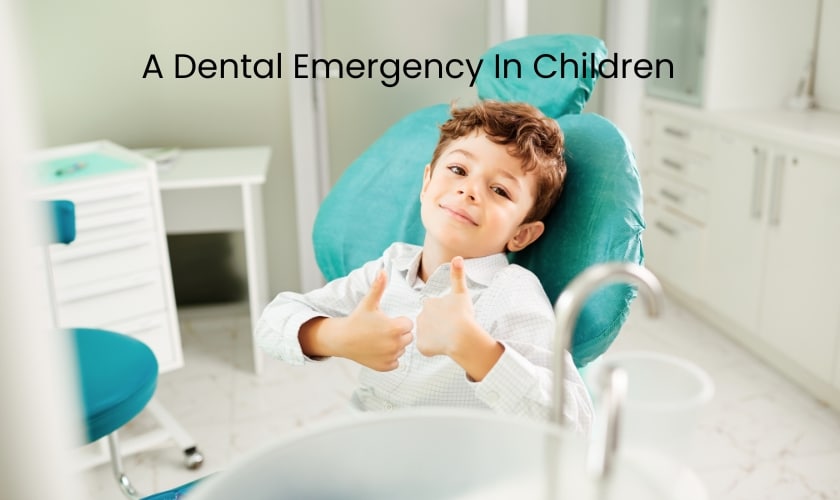
What Is Considered A Dental Emergency In Children?
Why did the toothbrush go to school? Because it wanted to be a little smarter! From lost teeth to rogue popcorn kernels, kids sure know how to keep us on our toes when it comes to their pearly whites. In matters of children’s dental emergencies, the stakes are a bit higher than just pulling weeds. But worry not, parents! Today’s blog will guide you through all the facts that constitute a dental emergency in children, and If you notice your child is experiencing any of the facts below, then consulting an emergency dentist in Woodbridge is highly recommended. Let us reflect on the world of ‘Tiny teeth with big troubles’.
Children are prone to dental emergencies due to their active lifestyles and developing teeth. Knowing what constitutes a dental emergency in children is crucial for parents and caregivers to provide the right treatment. Here are some common scenarios that qualify as dental emergencies in children and the necessary steps to take when faced with such situations.
1. Knocked-Out Tooth
A knocked-out tooth can be a distressing experience for both children and parents alike. It’s a situation that demands swift action to preserve the tooth and prevent further complications. Understanding why a knocked-out tooth is considered a dental emergency in children is crucial for knowing how to act fast on that dental urgency.
- If a child’s tooth gets knocked out due to trauma, it’s considered a dental emergency.
- Time is of the essence: Retrieve the tooth, hold it by the crown (not the root), and rinse it gently with water.
- Try to reinsert the tooth into the socket if possible, or store it in milk or saliva until you can reach a dentist.
- Contact an emergency dentist immediately for evaluation and possible re-implantation of the tooth.
Emergency dentist in Woodbridge is equipped to handle this kind of emergency with expertise and care, ensuring the best possible outcome for your child’s dental health. So, don’t delay in contacting an emergency dentist in Woodbridge, in case of a knocked-out tooth.
2. Fractured or Broken Tooth
A fractured or broken tooth is a common occurrence among children, often resulting from accidents, falls, or sports injuries. In this section, we’ll get deeper into the reasons behind this classification and learn the necessary actions to take during that period.
- Fractured or broken teeth can result from falls, sports injuries, or biting on hard objects.
- Rinse the mouth with warm water to clean the area and apply a cold compress to reduce swelling.
- Save any broken tooth fragments and bring them to the dentist.
- Seek prompt dental care to assess the extent of the injury and determine the appropriate treatment, which may include bonding, dental crowns, or other restorative procedures.
3. Severe Toothache
A severe toothache can disrupt a child’s daily activities and cause significant discomfort. Have a look at the reasons why a severe toothache is considered a dental emergency in children.
- Persistent or severe tooth pain can indicate an underlying dental problem, such as tooth decay, infection, or abscess.
- Rinse the mouth with warm salt water and gently floss around the affected tooth to remove any trapped debris.
- Avoid applying aspirin or heat directly to the tooth, as this can worsen the pain.
- Contact a pediatric dentist promptly for an evaluation and appropriate treatment to alleviate the child’s discomfort and address the underlying cause of the toothache.
4. Loose or Dislodged Tooth
A loose or dislodged tooth in a child can be a cause for concern and may require immediate attention.
- If a child’s tooth becomes loose or dislodged due to trauma, it requires immediate attention.
- Gently try to reposition the tooth back into its original position, but avoid forcing it.
- Apply a cold compress to reduce swelling and alleviate pain.
- Contact a dentist as soon as possible for further evaluation and appropriate treatment to stabilize the tooth and prevent further damage.
5. Object Lodged Between Teeth
Finding out an object lodged between a child’s teeth can be an unsettling experience for parents. However, knowing its outcome earlier can help children with these symptoms, alleviate anxiety, ensuring children receive the necessary care and relief from discomfort.
- Objects stuck between teeth can cause discomfort and potential damage to the surrounding gums and teeth.
- Encourage the child to rinse their mouth with warm water and attempt to dislodge the object using dental floss or an interdental brush.
- Avoid using sharp or pointed objects to remove the object, as this can cause injury.
- If the object remains lodged between teeth or causes pain, seek dental care for safe and effective removal.
6. Facial swelling or tenderness
Facial swelling or tenderness in children can indicate an underlying dental issue that requires immediate attention. Here are key points to consider:
- Facial swelling or tenderness may signal an underlying dental issue, such as infection, abscess, or injury.
- Ignoring facial swelling or tenderness can lead to worsening pain, spreading infection, and potential damage to surrounding tissues.
- Accurate evaluation and treatment by a pediatric dentist are essential to identify the cause of facial swelling or tenderness and initiate appropriate care.
- Parents should be vigilant in recognizing signs of facial swelling or tenderness in children and seek dental care promptly to ensure optimal oral health and well-being.
7. Excessive bleeding in the mouth
Excessive bleeding in the mouth is a concerning symptom that can indicate a dental emergency in children. Check out the facts to note down below.
- Excessive bleeding in the mouth may result from trauma, tooth injury, or gum disease. It can lead to blood loss, discomfort, and difficulty in eating or speaking.
- Immediate assessment and management by a pediatric dentist are necessary to control bleeding and address any underlying dental issues.
- Parents should remain calm, apply gentle pressure to the affected area with clean gauze, and seek urgent dental care for further evaluation and treatment.
- Neglecting excessive bleeding in the mouth can exacerbate the situation and increase the risk of complications, emphasizing the importance of timely intervention in dental emergencies involving bleeding.
At the end of the day, you have to keep in mind that Your proactive approach will not only save teeth but also keep discomfort at bay. When it comes to your child’s dental health, being proactive is key. That’s why reaching out to a trusted dentist in Woodbridge at the first sign of any concerns, is pivotal. It will secure your child’s beautiful smile, to flourish for years to come. By reaching out to your dentist, you’re not just addressing immediate concerns but also safeguarding your oral health and ensuring that any potential issues are dealt with before they escalate. Better safe than sorry!





